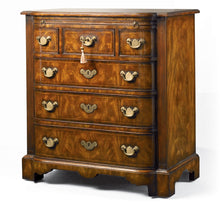-


18th Century Neapolitan Italian Style Mother of Pearl Inlaid commode
Regular price £20,575 GBPSale price £20,575 GBP Regular priceUnit price per -


Black Chinoiserie Lacquered Serpentine Commode
Regular price £16,775 GBPSale price £16,775 GBP Regular priceUnit price per -

King's Aviary Decorative Chest
Regular price £8,550 GBPSale price £8,550 GBP Regular priceUnit price per -


Brass Inlaid Serpentine Dressing Chest
Regular price £7,780 GBPSale price £7,780 GBP Regular priceUnit price per -


Noix Finish Dresser
Regular price £7,070 GBPSale price £7,070 GBP Regular priceUnit price per -


A serpentine mahogany chest of drawers with strapwork marquetry
Regular price £6,500 GBPSale price £6,500 GBP Regular priceUnit price per -


Boddington Commode
Regular price £5,960 GBPSale price £5,960 GBP Regular priceUnit price per -
Home Approval Service
View the item in your own home
-


A Remembrance of Times Past Chest Of Drawers
Regular price £5,835 GBPSale price £5,835 GBP Regular priceUnit price per -


A Chinoiserie Red Lacquer Serpentine Bombe Chest of Drawers
Regular price £5,485 GBPSale price £5,485 GBP Regular priceUnit price per -


Brass Inlaid Serpentine Chest of Drawers
Regular price £5,420 GBPSale price £5,420 GBP Regular priceUnit price per -


Kalahari and Ebonised Chest of Drawers
Regular price £4,160 GBPSale price £4,160 GBP Regular priceUnit price per -


The Captains Chest Of Drawers
Regular price £4,105 GBPSale price £4,105 GBP Regular priceUnit price per -


Mahogany Break Bowfront Chest of Drawers
Regular price £3,950 GBPSale price £3,950 GBP Regular priceUnit price per -


Flame Mahogany, Movingue and Rosewood Banded Chest of Drawers
Regular price £3,950 GBPSale price £3,950 GBP Regular priceUnit price per -

 New
NewThe Dorchester Dresser
Regular price £3,755 GBPSale price £3,755 GBP Regular priceUnit price per -
 To Order
To OrderBurr Oak Empire Style Nine Drawer Dresser
Regular price £3,695 GBPSale price £3,695 GBP Regular priceUnit price per -


Mahogany & Rosewood Crossbanded Nightstand
Regular price £3,465 GBPSale price £3,465 GBP Regular priceUnit price per -


Mahogany Break Bowfront Chest of Drawers
Regular price £3,425 GBPSale price £3,425 GBP Regular priceUnit price per -


Boddington Nightstand
Regular price £3,290 GBPSale price £3,290 GBP Regular priceUnit price per
Discover the Rich History and Craftsmanship of Chests of Drawers for the Bedroom







































